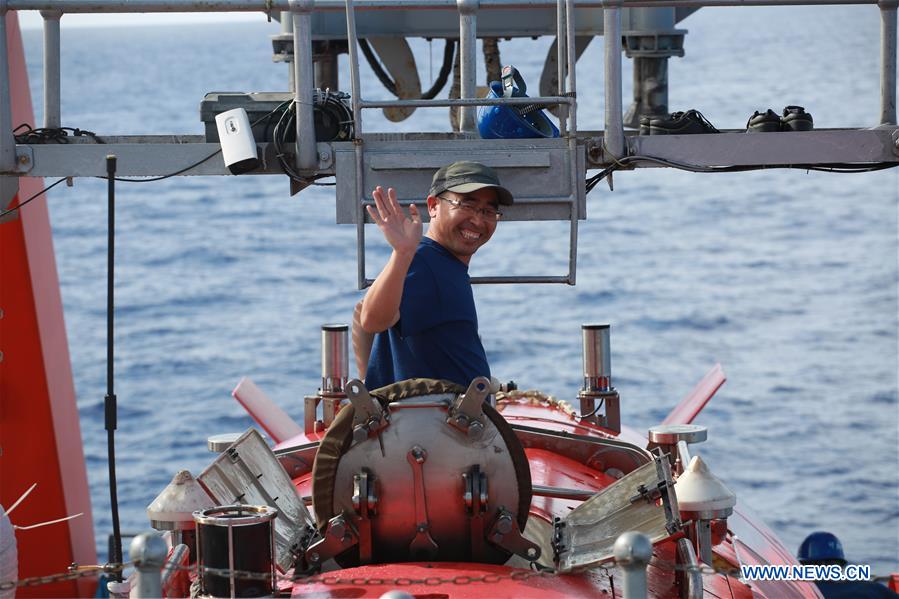
Liu Shiping waves as he walks out of submersible Jiaolong on May 23, 2017. China's manned submersible Jiaolong finished a dive in "Challenger Deep" in the Mariana Trench, the world's deepest known trench, on Tuesday. Xinhua News Agency journalist Liu Shiping descended inside the submersible along with scientists to 4,811 meters below the sea's surface. (Xinhua/Guo Songjiao)
BEIJING, May 23 (Xinhua) -- Diving thousands of meters under the sea and doing interviews has been the "coolest" and "most unforgettable" experience in Liu Shiping's career as a journalist.
Inside the submersible Jiaolong, Xinhua News Agency journalist Liu Shiping descended along with scientists to 4,811 meters below the sea's surface in the Mariana Trench, the world's deepest known trench, on Tuesday.
"It was like sitting in a spacecraft, roaming in the sky, and I could see 'shooting stars' passing by," Liu said, just hours after getting on the deck of the mother ship Xiangyanghong 09.
"We could see 'shooting stars' frequently when we descended to between 200 meters and 1,000 meters, and we even saw 'meteor showers' at a depth of about 400 to 500 meters," he said.
The stars were likely euphausiid plankton, which could have been frightened and ran away from the intruding submersible, according to Liu.
Jiaolong began its dive at 7:20 a.m. local time. Nearly two and a half hours later, it reached the planned depth of 4,811 meters, where scientists worked for more than three hours.
They conducted observation, sampling and surveying, and collected seawater, rocks and samples of marine life, including a sea cucumber, a sponge and two starfish, Liu said. The submersible also photographed the seabed.
According to the scientists, the rocks collected in this dive will help them understand how the Mariana Trench formed and evolved, while marine life samples will contribute to research on the diversity of deep-water creatures, eco-systems and biogeography.
Jiaolong was named after a mythical dragon living in the water.
The Chinese people have long dreamed of going up to the sky and down into the ocean on the back of a dragon. Instead of resorting to the mighty fabulous creature, China seems to have realized this dream by improving technology.
In 2003, China succeeded in sending the first Chinese astronaut, Yang Liwei, into space.
Last year, the country completed its longest manned space mission -- Tiangong-2 and Shenzhou-11 manned flight mission, which lasted over a month. The two astronauts Jing Haipeng and Chen Dong, acting as Xinhua special correspondents in space, sent back to earth several journals documenting their daily life and experiments in the capsule.
And now Jiaolong, with a length of 8.2 meters, is able to roam almost all oceanic waters on the planet. In June 2012, the submersible reached its deepest depth of 7,062 meters in the Mariana Trench.
China has also developed other underwater robots, including the unmanned Qianlong series. The Qianlong No. 2 underwater vehicle completed its first exploration in the southwest Indian Ocean in April 2016.
"Going into the deep oceanic world is a process full of wonder and surprises," Liu said.
The latest dive by Jiaolong was the first of 10 dives planned for the third stage of China's 38th oceanic expedition. The expedition, starting on Feb. 6, aims to explore the deep sea and help people know more about the ocean as well as ourselves.
Jiaolong made dives in the northwestern Indian Ocean and the South China Sea in the mission's first two stages.
Scientists also tested the submersible's technical and communication equipment, including its mechanical arms, through Tuesday's dive.
"The submersible's general technical conditions are stable, and various staff cooperated smoothly, fulfilling the scheduled mission and laying a foundation for deeper dives in the future," said Wu Changbin, commander of the expedition's third stage.
A second dive in the trench by Jiaolong is scheduled for Thursday.
The entire dive on Tuesday lasted 8 hours and 50 minutes, and Jiaolong surfaced at about 4 p.m. local time.
Liu felt he had just returned from the other world -- a dark but beautiful one.
"I can remember the light of the 'shooting stars.' In the deep sea surrounded by darkness and quiet, it made me feel the existence and pulse of life," Liu said.



